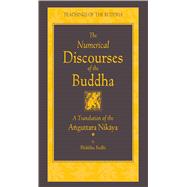The Numerical Discourses of the Buddha A Complete Translation of the Anguttara Nikaya

The Numerical Discourses of the Buddha A Complete Translation of the Anguttara Nikaya
- ISBN 13:
9781614290407
- ISBN 10:
1614290407
- Format: Hardcover
- Copyright: 10/16/2012
- Publisher: Wisdom Publications
Rent
Sorry, this item is currently unavailable.
Note: Supplemental materials are not guaranteed with Rental or Used book purchases.
Extend or Purchase Your Rental at Any Time
Need to keep your rental past your due date? At any time before your due date you can extend or purchase your rental through your account.
Summary
Like the River Ganges flowing down from the Himalayas, the entire Buddhist tradition flows down to us from the teachings and deeds of the historical Buddha, who lived and taught in India during the fifth century B.C. To ensure that his legacy would survive the ravages of time, his direct disciples compiled records of the Buddha’s teachings soon after his passing. In the Theravada Buddhist tradition, which prevails in Sri Lanka and Southeast Asia, these records are regarded as the definitive “word of the Buddha.” Preserved in Pali, an ancient Indian language closely related to the language that the Buddha spoke, this full compilation of texts is known as the Pali Canon. At the heart of the Buddha’s teaching were the suttas (Sanskrit sutras), his discourses and dialogues. If we want to find out what the Buddha himself actually said, these are the most ancient sources available to us. The suttas were compiled into collections called “Nikayas,” of which there are four, each organized according to a different principle. The Digha Nikaya consists of longer discourses; the Majjhima Nikaya of middle-length discourses; the Samyutta Nikaya of thematically connected discourses; and the Anguttara Nikaya of numerically patterned discourses. The present volume, which continues Wisdom’s famous “Teachings of the Buddha” series, contains a full translation of the Anguttara Nikaya. The Anguttara arranges the Buddha’s discourses in accordance with a numerical scheme intended to promote retention and easy comprehension. In an age when writing was still in its infancy, this proved to be the most effective way to ensure that the disciples could grasp and replicate the structure of a teaching. A broad survey of the Anguttara Nikaya shows that its primary focus is on practice, and it treats practice from a wide-angle perspective. The subjects of the discourses range from the basic ethical observances recommended to the busy layperson, through the pillars of mind training, to the highest meditative attainments. The Anguttara is also distinguished among the four Nikayas by its interest in types of persons, which it describes and classifies in detail, often with stunning similes. In such a work, it is fitting that the Buddha appears, not merely as a teacher, but as a real person with his own life story and achievements.The previous volumes in Wisdom’s “Teachings of the Buddha” series have been hailed by practitioners and scholars alike for their combination of elegance and precision. They are widely regarded as the definitive translations of these foundational sacred works. Since this large collection has no intrinsic thematic scheme, the translator provides extensive guidance for the reader in his introduction, annotations, and indexes. He has also created a guide to the Anguttara that classifies the discourses according to a thematic progression. Readers wishing to discover for themselves the wisdom of the historical Buddha will find no better guide. The Anguttara Nikaya is the fourth of the four main collections of discourses, or suttas, of the Pali Canon, the texts that Buddhists in South and Southeast Asia regard as “word of the Buddha.” The work is arranged according to the numerical scheme that underpins each discourse. In a period in Indian history before writing was widely used, memorization of the teachings required that they could be easily retained in mind, and the use of numbers served this purpose well. The name Anguttara, or “incremental,” is given to this collection because the number of items in the suttas of each successive part increases incrementally over those of the preceding part. A broad survey of its contents shows a preponderance of texts dealing with Buddhist practice. Their subjects range from the basic ethical observances recommended to the busy layperson, through the pillars of mind training, to the highest meditative state. The Anguttara is distinguished among the four Nikayas by its interest in defining and describing types of persons. In such a work, it is fitting that a substantial number of suttas are devoted to the Buddha himself, not merely as the teacher and expounder of the Dhamma but as a person with his own life story and achievements.The previous volumes in this series have been hailed by practitioners and scholars alike for their combination of elegance and precision and have become the definitive translations of these foundational sacred works. Since this large compendium has no intrinsic thematic progression, Bhikkhu Bodhi helpfully provides extensive guidance for the reader in his introduction, thematic guide, annotation, and indexes. Readers wishing to discover for themselves the wisdom of the historical Buddha will find no better guide.






